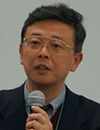
Lab-on-a-Chip, Microfluidics & Organ-on-a-Chip Asia 2024
大空厅
2024年11月7日
08:00
Conference Registration, Materials Pick-Up, Coffee, Tea and Networking in Exhibit Hall (Banquet Room OZORA)
会议报到、资料分发、提供饮料(咖啡・茶饮)、社交活动:展览厅(大空厅)
鹤厅 A
2024年11月7日
08:50
Conference Plenary Session Chaired by:
整体会议的主题演讲:
Professor Lydia Sohn, UC-Berkeley
Professor Noah Malmstadt, University of Southern California
The Plenary Session Sets the Tone for the Conference Topics to be Addressed:
主题演讲将为会议预定审议的主题定下方向性:
Microfluidics/Lab-on-a-Chip
微流控/生物功能晶元
Lipid Nanoparticles (LNPs)
脂质纳米颗粒(LNPs)
Organs-on-Chips
器官晶片(Organs-on-Chips)
鹤厅 A
2024年11月7日
09:00

Yoshinobu Baba, Professor, Nagoya University, Japan
Nanobiodevices and Quantum Life Science for Future Healthcare
纳米生物器件和量子生命科学在未来医疗保健中的应用
We have investigated nanobiodevices and quantum life science for biomedical applications and healthcare. Nanowire devices are extremely useful to isolate extracellular vesicles from body fluids and vesicle-encapsulated microRNA analysis. The device composed of a microfluidic substrate with anchored nanowires gives us highly efficient collections of extracellular vesicles in body fluids and in situ extraction for huge numbers of miRNAs (2,500 types) more than the conventional ultracentrifugation method. Nanowire devices gave us the miRNA date for several hundred patients and machine learning system based on these miRNA data enabled us to develop the early-stage diagnosis for lung cancer, brain tumor, pancreas cancer, liver cancer, bladder cancer, prostate cancer, diabetes, heart diseases, and Parkinson disease. We succeeded to identify high-grade serous ovarian carcinoma-specific extracellular vesicles by polyketone-coated nanowires and the spatial exosome analysis using cellulose nanofiber sheets to reveal the location heterogeneity of extracellular vesicles. Nanowire-nanopore devices combined with AI (machine learning technique) enable us to develop mobile sensors for SARS-CoV-2, PM2.5, bacteria, and virus in the environment. Nanopore sensing is applied to the identification of viral vector characteristics with the sub-nm resolution. MEXT Quantum Leap Flagship Program (Q-LEAP), which I lead, has been developing biological nano quantum sensors, quantum technology-based MRI/NMR, and quantum biology and biotechnology. Nanodiamonds, with nitrogen-vacancy centers (NVC), and quantum dots are applied to develop quantum sensors for quantum switching intra vital imaging for iPS cell based regenerative medicine, and quantum photo immuno-therapeutic devices for cancer. Nanodiamond with NVC is applied to in situ measurements of intracellular thermal conductivity and implication of thermal signaling in neuronal differentiation revealed by manipulation and measurement of intracellular temperature.
鹤厅 A
2024年11月7日
09:30

Nancy Allbritton, Frank and Julie Jungers Dean of the College of Engineering and Professor of Bioengineering, University of Washington, United States of America
Overview of the Organ-on-a-Chip Field
器官晶元领域概述
鹤厅 A
2024年11月7日
10:00

Steven Soper, Professor, Departments of Chemistry and Mechanical Engineering, University of Kansas, United States of America
Integrated Microfluidic Systems for the Comprehensive Analysis of Liquid Biopsy Samples
用于液体活检样本综合分析的整合微流控系统
Liquid biopsies are extremely popular for managing cancer diseases due to the minimally invasive nature of their acquisition. Circulating tumor cells (CTCs) generated from solid tumors, and circulating leukemia cells (CLCs) produced from leukemias, are biomarkers that can be secured from blood using microfluidic technologies. However, many of these platforms require manual sample handling, which can generate difficulties when translating CTC/CLC assays into the clinic due to potential sample loss, contamination, and the need for highly trained operators. In this presentation, I will discuss a system modularity approach for the analysis of rare targets (SMART-Chip) comprised of three task-specific modules that can fully automate processing of CTCs and CLCs. The modules are used for affinity selection of CTCs/CLCs from blood with subsequent photorelease (catch and release), simultaneous counting and viability determinations of the selected/released cells, and staining/imaging of the cells for immunophenotyping as well as looking for chromosomal abnormalities (FISH). The modules are interconnected to a fluidic motherboard populated with valves, interconnects, pneumatic control channels, and a fluidic network. The SMART-Chip components were made from thermoplastics via micro-replication, which significantly lowered the cost of production making it amenable for clinical implementation. The utility of the SMART-Chip was demonstrated by processing blood samples secured from colorectal cancer patients. We were able to affinity select EpCAM expressing CTCs with high purity (0-3 WBC contaminants/mL of blood), enumerate the selected cells, determine their viability, and immunophenotype them. In the case of CLCs, CD19-expressing B-cells were selected from pediatric patients suffering from acute lymphoblastic leukemia (ALL) to determined disease recurrence from minimum residual disease. The CLCs could also be subjected to Fluorescence In Situ Hybridization (FISH) to search for ETV6/RUNX1 fusions that have prognostic value for ALL patients. The assays could be completed in <2 h using the SMART-Chip, while manual processing on a benchtop required >48 h when incorporating FISH.
大空厅
2024年11月7日
10:30
Mid-Morning Coffee Break and Networking with Exhibitors, Colleagues and View Posters
上午休息时间、与展商和同业界其他公司互动,观看海报
鹤厅 A
2024年11月7日
11:00

Aram Chung, Professor, School of Biomedical Engineering, Korea University, Republic of Korea
Microfluidic Platforms for Immunotherapy and Genome Editing
用于免疫治疗和基因组编辑的微流控平台
The internalization of biomolecules in cells, such as DNAs, RNAs, plasmid DNAs, proteins, and CRISPR systems, is an indispensable process for studies ranging from basic biology to clinical applications. Tools such as viral vectors, cationic lipids, and electroporators have traditionally been used to deliver external biomolecules into cells; however, they are suboptimal for achieving high levels of delivery while preserving cell viability, phenotype, and function.
To address these challenges, our research group is focusing on developing next-generation microfluidics-based intracellular delivery platforms. By leveraging intrinsic fluid-cell interactions within confined microchannels, we create transient discontinuities on the cell membrane, internalizing external biomolecules into the cells. Using this principle, we have successfully demonstrated highly effective biomolecule delivery into various cells, including human primary stem and immune cells with high cell stability. In this talk, I will discuss our recent microfluidic intracellular delivery platform developments and their promising applications in genome editing and cancer immunotherapy.
鹤厅 A
2024年11月7日
11:30

Tae-Joon Jeon, Professor, Inha University, Republic of Korea
Innovative Applications of Lipids and Microfluidics: Tools for Advanced Drug Delivery Systems and Biosensing
脂质和微流控的创新应用:用于先进药物输送系统和生物感测的工具
This seminar will explore the use and potential of biomimetic membranes and their derivatives in various scientific and engineering applications. These membranes have potential as drug delivery platforms and biosensing technologies. In addition, the integration of functional membrane proteins into these biomimetic constructs has opened up opportunities for engineering applications. This talk will highlight our groundbreaking work with biomimetic membranes, including innovative applications such as drug delivery systems, aquaporin-based water purification technology, and biosensing applications. Of particular interest, our research introduces a novel drug delivery platform called "vesosomes" or "peas-in-a-pod". These liposomes have multiple compartments that allow for controlled and sustained release of contents. In addition, we will present how microfluidic systems are being used to more effectively fabricate drug delivery systems and biosensors.
鹤厅 A
2024年11月7日
12:00

Noah Malmstadt, Professor, Mork Family Dept. of Chemical Engineering & Materials Science, University of Southern California, United States of America
Understanding Three-Dimensional Microfluidic Design to Optimize Lipid Nanoparticle Fabrication
了解 3D 微流体设计以优化脂质纳米颗粒的制造
3D printing brings with it a plethora of advantages for microfluidic applications. Principle among these are rapid prototyping, iterative design, and the ability to avoid the cost and overhead of cleanrooms. However, there is also an inherent advantage in being able to design and build devices in a truly three-dimensional, rather than layer-by-layer, geometry. One simple domain in which the advantages of true 3D routing are clear is in mixing. Control over a 3D geometry allows for multiple complex mixing configurations--herringbones, relamination mixers, chaotic advection--to be trivially constructed and recombined. We have deployed these principles of 3D design to design simple, compact devices for the high-throughput manufacture of lipid nanoparticles (LNPs). LNPs are drug delivery vehicles of increasing importance: they have demonstrate effectiveness and scalability as the delivery vehicles for mRNA-based vaccines against SARS-CoV-2 and emerging research is demonstrating that they have broad applications in vaccine delivery and beyond. This talk discusses how microfluidic mixing controls the size, structure, and uniformity of LNPs with several drug-like payloads including mRNA and therapeutic peptides.
鹤厅 A
2024年11月7日
12:30

Manabu Tokeshi, Professor, Division of Applied Chemistry, Hokkaido University, Japan
Fabrication of Engineered Lipid Nanoparticles Using Microfluidic Devices
利用微流控设备制备人工脂质纳米颗粒
Recently, the production of lipid nanoparticles (LNPs) using microfluidic devices has attracted much attention. Microfluidic devices provide many advantages for drug-loaded LNP production, including precise LNP size controllability, high reproducibility, high-throughput optimization of LNP formulation, and continuous LNP-production processes. Various microfluidic devices have been developed and used to produce LNPs encapsulating RNA, DNA, ribonucleoproteins (RNPs), drugs, and others. In fact, microfluidic devices are also being used in the development of Onpattro®, which was approved by the FDA in 2018 as an RNA interference therapeutic drug. Recently, we developed a microfluidic device named iLiNP® (invasive lipid nanoparticle production) device for LNP production based on computational fluid dynamics and LNP formation mechanism. It enabled the LNP size tuning at 10 nm intervals in the size range from 20 to 100 nm. Using this device, we have not only developed pharmaceutical applications by producing LNPs encapsulating nucleic acids and drugs, but also devices integrating the post-processing of LNP production and devices for mass production. Moreover, very recently, we have found that iLiNP devices are also highly suitable for the fabrication of functional (engineered) lipid nanoparticles such as artificial exosomes and virus-like particles. In this lecture I will present these results.
鹤厅 A
2024年11月7日
13:00
Networking Lunch in the Exhibit Hall (Japanese Bento)
展览厅的交流午餐会(提供便当)
Network with Exhibitors and Colleagues, View Posters
与展商和同业界其他公司互动,观看海报
鹤厅 A
2024年11月7日
13:59
Afternoon Session Title: Lab-on-a-Chip and Microfluidics 2024 -- Technologies and Applications
下午会议议题:生物功能晶元与微流控(2024)——技术与应用
鹤厅 A
2024年11月7日
14:00

Daniel Citterio, Professor, Keio University, Japan
CRISPR/Cas Assays Fully Integrated Into Paper-based Platforms
CRISPR/Cas检测完全整合到纸质平台中
There has been a rapid growth in the development of analytical assays based on the CRISPR/Cas nuclease enzyme system. On the other hand, paper-based analytical devices (PADs) have gained a lot of attention as platforms potentially suitable for point-of-care testing (POCT) applications. Despite both approaches having multiple advantages, their combination into fully integrated POCT devices has rarely been reported. In most combinations of CRISPR/Cas technology with PADs, the latter is simply used for a final signal detection step, while otherwise the assay is performed in the liquid phase in tubes. This presentation will be showing that the two technologies can be successfully combined into fully integrated devices, and that the CRISPR/Cas system is suitable for on-device storage, a prerequisite for future POCT applications. As a proof-of-concept for a practical assay of clinical relevance, a PAD for the highly sensitive quantitative determination of the hepatitis B virus surface antigen (HBsAg) is presented. The developed assay achieved a limit of detection in the order of 30 pg/mL in undiluted spiked porcine blood plasma samples, and was also applied to undiluted spiked whole blood with signal readout on a portable smartphone setup. The presented results demonstrate that the CRISPR/Cas system is a promising tool for use in the development of highly sensitive paper-based assays.
鹤厅 A
2024年11月7日
14:30

Hirofumi Shintaku, Professor, Institute for Life and Medical Sciences, Kyoto University
Nanoscale Electrokinetics Empowers Mechano Phenotyping of Single Cells
纳米级电动力学增强了单细胞的机械表型分析
Nanopore electroporation uses nanostructures to create focused electric fields, which form pores in lipid bilayers of living cells with low invasiveness. We introduce ELASTomics, an approach that parallelly profile cell surface tension and gene expression of thousands of single cells leveraging nanopore electroporation and single-cell RNA-sequencing. We show that our system dissects the heterogeneity in cellular mechanics and uncovers the transcriptomic regulatory mechanism in cancer malignancy, cell differentiation, and cellular senescence.
鹤厅 A
2024年11月7日
15:00

Anderson Shum, Professor, Department of Mechanical Engineering; Director, Advanced Biomedical Instrumentation Centre, University of Hong Kong, Hong Kong
Designer Microstructures by Assembly at Aqueous Phase-Separating Interfaces
通过在水相分离介面上的组装来设计微结构
Aqueous phase separation gives rise to a variety of structures in aqueous multi-component systems. The dynamic interplay between phase separation and interfacial phenomena are delicately determined by the molecular interactions of the underlying components with each other, as well as with the solvent phases and the interfaces formed. Hence, formation and assembly of microstructures can by manipulated by designing the molecular arrangements of the components and solvents, as well as adjusting the phase behaviors and interfacial properties. The relationship between the properties and the molecular arrangements is intriguing but remains inadequately investigated. The level of complexity and hierarchical that can be involved calls for systematic investigation across multiple scales ranging from microscale to molecular scale. A thorough understanding of these will not only enable the bottom-up design of new materials, but may also shed light on how biological systems, such as biomolecular condensates, operate. In this talk, I will share some of our findings in conducting experiments in assembling material structures at aqueous phase-separating interfaces.
大空厅
2024年11月7日
15:30
Late Afternoon Coffee and Tea Break in the Exhibit Hall + Poster Viewing
下午休息时间(提供饮料)+参观海报:展览厅
鹤厅 A
2024年11月7日
16:00

Sven Kreutel, CEO, Particle Metrix, Inc., USA & Germany
Characterization of Extracellular Vesicles and Other Biological Nanoparticles using Nanoparticle Tracking Analysis (NTA)
使用奈米颗粒追踪分析 (NTA) 来表征细胞外囊泡和其他生物奈米颗粒
Nanoparticle Tracking Analysis (NTA) has emerged as a fast and vital characterization technology for Extracellular Vesicles (EVs), Exosomes and other biological material in the size range from 30 nm to 1 μm. While classic NTA scatter operation feeds back the size and total particle concentration, the user typically cannot discriminate whether the particle is a vesicle, protein aggregate, cellular trash or an inorganic precipitate. The fluorescence detection capabilities of f-NTA however enables the user to gain specific biochemical information for phenotyping of all kinds of vesicles and viruses. Alignment-free switching between excitation wavelengths and measurement modes (scatter and fluorescence) allow quantification of biomarker ratios such as the tetraspanins (CD63, CD81 and CD9) within minutes. Furthermore, specific co-localization studies using c-NTA gives a deeper understanding of the composition of biomarker on single particle.
鹤厅 A
2024年11月7日
16:30

Jing Chen, Founder & CEO, Hicomp Microtech, United States of America
How to Take Your Chips Out of the Lab? Exploring PDMS Volume Production
如何将晶元带出实验室?探索PDMS的量产方法
This talk delves into the journey of scaling microfluidic chips from laboratory prototypes to market-ready products through PDMS volume production. It will cover the intricate process of transitioning from PDMS to industrial-standard injection molding, highlighting the efficiency and challenges involved. A case study on liquid biopsy using PDMS chips will illustrate practical applications, followed by a discussion on pricing strategies for PDMS manufacturing. The talk will conclude with a look at the future potential of PDMS applications in life sciences.
鹤厅 A
2024年11月7日
17:00

Michael Breadmore, Professor, University of Tasmania
3D Printed Fluidic Devices
3D列印流体设备
An overview of our research into 3D printed fluidic devices with our latest developments on at-site nutrient measurement in soil.
鹤厅 A & B
2024年11月7日
17:30
Joint Session -- Flow Chemistry Track and Microfluidics Track Joined Together
联合单元:流动化学分会和微流体分会联合举行
鹤厅 A & B
2024年11月7日
17:35

Paul Watts, Distinguished Professor and Research Chair, Nelson Mandela University, South Africa
Has the Flow Changed? From Microfluidic Research to Meso Reactor Synthesis
从微流体研究到介观反应器合成,流程是否发生了变化?
When microfluidic reactor technology was first introduced it was seen as being a research and development tool suitable for small scale production, however it is now being used to produce large quantities of product. The key driver in these examples being safety, where the excellent mixing and heat transfer characteristics of micro structured reactors enables these highly exothermic reactions to be safely performed. Nevertheless there is now a plethora of commercial reactors on the market, which means that most companies are investigating this technology to rapidly screen reactions utilising continuous flow, leading to the identification of reaction conditions that are suitable for use at a production level. It is this system flexibility that has the potential to reduce both the time taken and risk associated with transferring reaction methodology from research to production. A selection of reactions demonstrated using this technology will be outlined, which enable local production within Africa.
鹤厅 A & B
2024年11月7日
18:00

Noah Malmstadt, Professor of Chemical Engineering and Materials Science, University of Southern California, United States of America
Flow Reactors for Sustainable Colloidal Synthesis of Nanocrystals
用于奈米晶体可持续胶体合成的流动反应器
Nanocrystal materials including metals, metal carbides and phosphides, and perovskites have broad applications in the transition to sustainable energy. In particular, they can serve as next-generation catalysts for carbon dioxide conversion, fuel cell membranes, and biofuel upgrading. While there are well-established routes to the colloidal synthesis of these materials, they are highly sensitive to local reaction environment, and it has been challenging to scale their production using traditional chemical manufacturing technologies. On the other hand, millifluidic flow reactors, which can deliver excellent reaction environment uniformity, are a promising route to the production of colloidal nanocrystals. Recent work has demonstrated that scaling millifluidic reactors via parallelization can approach industrially relevant product throughput. Flow reactors are also powerful tools for reaction discovery. Here, we present two examples of how flow reactor systems can be used to understand the parameter space of nanocrystal synthesis reactions and identify targeted reaction conditions. The first of these examples is the production of Pt nanoparticles (NPs) in ionic liquids (ILs). Ionic liquid (IL) solvents represent a special class of low-volatility, generally safe solvents that are particularly easy to recycle. While the capacity to produce metallic NPs in ILs has been known for decades, we know little about the mechanism of these reactions and in particular how solvent choice can guide this mechanism. To discover the mechanism of Pt NP fabrication in ILs, we have constructed a flow reactor with in-line spectrophotometric monitoring of the products. To determine reaction component concentration from the complex spectral data, we have implemented a machine learning (ML) algorithm that can determine concentration. By measuring product concentration as a function of residence time, we are able to determine the IL solvent-dependent reaction kinetics. The second example involves synthesizing photoactive perovskite nanocrystals in a parallel flow reactor system. By controlling hydrodynamic resistance across the channel network, we are able to rapidly screen composition space for the reactants. Analyzing these high throughput data with a neural network facilitates the construction of a map between reactant composition space and product crystal phase space, allowing for manufacturing to target a desired product phase.
鹤厅 A & B
2024年11月7日
18:30

Steven Soper, Professor, Departments of Chemistry and Mechanical Engineering, University of Kansas, United States of America
Label-Free Detection and Identification of Single Molecules for Applications in Medicine and Biology
用于医学和生物学的单分子无标记检测和鉴定
Resistive Pulse Sensing (RPS) is a label-free and single-molecule detection approach that requires simple instrumentation to implement and as such, can be mobilized to be integrated into in vitro diagnostic assays for not only detecting but identifying key disease-associated biomarkers with high analytical sensitivity. Thus, it makes it a logical choice for coupling with liquid biopsy markers for the precision management of a variety of diseases. We have developed a unique measurement modality and sensor technology (dual in-plane nanopore sensor) that couples RPS to nanoscale electrophoresis, which has recently garnered attention due to unique phenomena that occurs within the nanometer domain, but does not occur in the microscale domain. These scale-dependent phenomena include high surface area-to-volume ratios, electrical double layer overlap generating parabolic flows, concentration polarization, transverse electromigration, surface charge dominating flow, and surface roughness effects. Our devices, which are made from plastics via high-scale production modalities (injection molding), consist of channels with dimensions ranging from 1 to 100 nm (effective diameter) that are 10’s of microns in length. In this talk, I will discuss the operational parameters and unique applications of our dual in-plane nanopore sensor for three compelling applications: (1) determining the fill status (empty versus full) of adeno-associated viruses (AAVs), which serve as carriers of gene therapy drugs; (2) peptide fingerprinting of single protein molecules; and (3) DNA/RNA single-molecule sequencing.
大空厅
2024年11月7日
19:00
Networking Reception in the Exhibit Hall with Japanese Beer and Japanese Sake -- Network with Exhibitors, Colleagues and View Posters
提供日本啤酒和日本清酒的交流招待会(于展厅):与参展商及业界其他企业交流、观赏海报
大空厅
2024年11月7日
20:00
Close of Day One of the Conference
会议第1日的闭幕致辞
大空厅
2024年11月8日
08:30
Morning Coffee, Tea and Networking in the Exhibit Hall
晨间咖啡、社交活动:展览厅
鹤厅 A
2024年11月8日
08:55
Morning Session Title: Convergence of Lab-on-a-Chip/Microfluidics with Related Fields
上午会议议题:生物功能晶元/微流控在相关领域的整合
鹤厅 A
2024年11月8日
09:00

Jonghoon Choi, Professor, Chung-Ang University, Republic of Korea
Cell-Surface Glycan Targeting Lectin Nanoparticles for the Theragnosis of Tumor
用于肿瘤治疗的细胞表面聚糖靶向凝集素纳米颗粒
The unique profile of up-regulated glycosylation in metastatic cancer cells may form the basis for the development of new biomarkers for the targeting and diagnosis of specific cancers. This work will introduce a pancreatic cancer cell-derived exosome detection and tumor targeting technology, which is based on the specific binding of lectins to distinctive glycan profiles on the surface of exosomes and tumor cells. Lectins with a high and specific affinity for sialic acid or fucose were attached to bifunctional nanoparticles, which facilitated interactions with pancreatic cancer cell-derived exosomes in a microfluidic device. The lectin affinity to surface glycan of tumor cells can also be the strategy to treat tumor cells with lectin-nanoparticles in the immuno- and photothermal therapy. This strategy opens the possibility to achieve a new early diagnosis marker and target moiety based on the surface-glycan properties of cancer cells.
鹤厅 A
2024年11月8日
9:30

Jessie S. Jeon, Associate Professor, KAIST, Republic of Korea
Microphysiological System for Disease Modeling and Drug Testing
用于疾病模型和药物检测的微生理系统
3D in vitro microphysiological systems are developed for mimicking different disease models and to be used as drug screening assays. I will describe developed systems for investigating human cancer microenvironment and its usage in anti-cancer drug delivery. The developed system enables recreation of different aspects of cancer microenvironment with vasculature and either organ-specific cells or immune cells in addition to cancer cells. The advantages of using microfluidic systems as disease model and drug screening assay include requiring only small sample volume, minimized manual repetition and relatively fast turnout time. Overall, the microfluidic model developed can reproduce different pathological microenvironment, and can give the insights on drug efficacies for particular microenvironments.
鹤厅 A
2024年11月8日
10:00

Mandy Esch, Project Leader, National Institute of Standards and Technology (NIST), United States of America
Development of Pumpless Single-Organ and Multi-Organ MPS
无泵单器官和多器官MPS的开发
Single and multi-organ microphysiologic systems (MPS) can be used to detect secondary drug toxicities stemming from drug metabolites. Here we describe how to design and prototype such systems to replicate key aspects of the human body that influence the concentration of drug metabolites within the system. Using 3D printing we have prototyped and tested several microfluidic MPS that operate with liver and heart tissues and that can recirculate near-physiological amounts of cell culture medium. We have also developed several devices that recirculate small amounts of cell culture medium in a way that makes it feasible to culture mechano-sensitive cells such as HUVEC or GI tract epithelial cells within the system. The talk given here is a summary of our efforts in this area.
大空厅
2024年11月8日
10:30
Mid-Morning Coffee Break and Networking in the Exhibit Hall
上午休息时间、社交活动:展览厅
鹤厅 A
2024年11月8日
10:55
Session Title and Focus: Organs-on-Chips
单元议题与焦点:生物功能晶元
Plenary Speaker and Session Chairperson: Dr. Danilo Tagle, NCATS
主题演讲者・单元议长:Dr. Danilo Tagle, NCATS
鹤厅 A
2024年11月8日
11:00

Danilo Tagle, Director, Office of Special Initiatives, National Center for Advancing Translational Sciences at the NIH (NCATS), United States of America
NIH Translational Centers for Microphysiological Systems (TraCe MPS)
关于NIH的TraCe MPS(微生理系统转化中心)
Over the last decade, the National Center for Advancing Translational Sciences (NCATS) as part of the US National Institutes of Health (NIH) have supported the development and use of microphysiological systems (MPS) or tissue chips in testing candidate therapies for safety and efficacy, in modeling human diseases, in designing clinical trials, and in applications for precision medicine. Recently, NCATS has established four Translational Centers for Microphysiological Systems (TraCe MPS) in the US to support the widespread adoption and use of tissue chip technology, especially in drug discovery and development. These Centers aims to support research that will accelerate the translational use of MPS in drug (both human pharmacological and biological products) development through regulatory acceptance and adoption for industrial use, by establishing MPS that are fit-for-purpose for industry needs and have specific defined context-of-use (CoU) and will be developed with consideration of applicable expectations to achieve regulatory approval. The TraCe MPS program is in partnership with the US Food and Drug Administration (FDA) and the Critical Path. The four centers will focus on qualification of MPSs developed for liver, kidney, barrier-function, and pregnancy and women’s health. The These Centers will further the development of these MPSs as drug development tools (DDTs) that, once qualified, will be made commercially available to fill unmet needs in drug development.
鹤厅 A
2024年11月8日
11:30

Lydia Sohn, Almy C. Maynard and Agnes Offield Maynard Chair in Mechanical Engineering, University of California-Berkeley, United States of America
Title to be Confirmed
议题未定
鹤厅 A
2024年11月8日
12:00

Hiroshi Kimura, Professor, Micro/Nano Technology Center, Tokai University, Japan
User-Friendly MPS Platforms for Commercialization
便于使用者的MPS商业化平台
Microphysiological system (MPS) has been widely studied as a novel method for estimating the effects and toxicities of drugs, providing an alternative to animal tests in drug discovery. In the EU and USA, various types of MPS are commercially available by many companies, and more recently, their practical application has been well promoted. Although MPS has been actively researched in Japan, there has been almost no practical MPS. Japan Agency for Medical Research and Development (AMED) has conducted an MPS development project to commercialize domestically produced MPS since 2017. Our research group has developed two types of MPS, Fluid3D-X® (TOK) and BioStellarTM Plate (Sumitomo Bakelite), for commercialization in collaboration with Japanese manufacturing companies in the project. Our proposed MPSs are expected to facilitate high-quality cell-based assays in drug discovery and biology due to their ease of use and high throughput. In this presentation, I present an overview of these MPS functions and provide examples of drug evaluation studies using the MPSs.
鹤厅 A
2024年11月8日
12:30

Meghan Hemond, Senior Business Development Engineer, Edge Precision Manufacturing, United States of America
Materials and Manufacturing Methods for Thermoplastic Products
热塑性制品的材料和制造方法
How the selection of materials and manufacturing processes impact the product development roadmap and resulting products.
大空厅
2024年11月8日
13:00
Networking Lunch in the Exhibit Hall (Japanese Bento)
展览厅的交流午餐会(提供便当)
Network with Exhibitors, Colleagues and View Posters
与展商和同业界其他公司互动,观看海报
鹤厅 A
2024年11月8日
13:59
The NIH Complement to Animal Research in Experimentation (Complement-ARIE) Program to Advance New Approach Methodologies (NAMs)
透过NIH 的 Complement-ARIE 计划推进新方法 (NAM)
The 21st century has been a time of accelerated technological advancement. New and evolving methodologies, including gene editing, artificial intelligence (AI), induced pluripotent stem cells (iPSCs), and advanced 3D models are fundamentally changing the way biomedical science is done. These technologies have greatly enabled and contributed to the development and application of New Approach Methodologies (NAMs). NAMs can be defined as any in vitro, in chemico or computational (in silico) method that when used alone, or in concert with others, enables improved chemical and drug safety assessment through more human-relevant models and as a result, can contribute to the replacement of in vivo studies. While animal models continue to be vital to advancing scientific knowledge, NAMs offer unique strengths that, when utilized strategically or in combination, can enable researchers to answer previously difficult or unanswerable questions, especially in areas where in vivo models are lacking or have consistently underperformed.
The recent passage into law of the FDA Modernization Act 2.0 enabled drug registration without the absolute requirement for the use of animals in safety toxicology assessment where alternative risk assessment tools are available. An NIH Complement Animal Research In Experimentation (Complement-ARIE) working group (WG) has been engaged in robust strategic planning activities and stakeholder outreach focused on developing a unifying vision for building on ongoing efforts to develop, standardize, validate, and use NAMs, and identifying opportunities for innovation and coordination with other stakeholders.
The overarching goal of the Complement-ARIE program is to catalyze the development, standardization, validation, and use of human-based NAMs that will transform the way we do basic, translational, and clinical sciences. The program goals include:
• Better model and understand human health and disease outcomes across diverse populations.
• Develop NAMs that provide insight into specific biological processes or disease states.
• Validate mature NAMs to support regulatory use and standardization.
• Complement traditional models and make biomedical research more efficient and effective.
Complement-ARIE will significantly advance understanding of human health and etiology of human disease, have near-term application in fields such as mechanism elucidation, precision medicine, safety pharmacology, predictive toxicology, efficacy evaluation of candidate therapeutics, and provide a range of ready and standardized models for health and disease biology.
Session Chaired by Dr. Danilo Tagle, NCATS
セッション議長: Dr. Danilo Tagle, NCATS
鹤厅 A
2024年11月8日
14:00

Ryuji Yokokawa, Professor, Department of Micro Engineering, Kyoto University, Japan
Microphysiological Systems (MPS) With Perfusable Vascular Network for Pharmacological and Infectious Disease Applications
用于药理学和传染病应用的具有可灌注血管网路功能的微生理系统 (MPS)
Microfluidic devices have been used to answer scientific questions in many lifescience research fields. Although applicability of microphysiological systems (MPS) to drug development attracts many researchers, MPS is also widely used to address fundamental scientific questions in biology. We have employed two approaches to create the interface between organ cells and vascular networks: a two-dimensional method in which organ cells and vascular endothelial cells are co-cultured on a porous membrane such as Transwell (2D-MPS), and a three-dimensional method in which the spontaneous patterning ability of vascular endothelial cells is utilized (3D-MPS). As an example of 2D-MPS, we developed a renal proximal tubule model and a glomerular filtration barrier model using iPSC-derived organoid cells, which enables us to evaluate reabsorption, filtration, and nephrotoxicity. It was applied to airway and alveoli models to evaluate SARS-CoV-2 and influenza infections. For 3D-MPS, angiogenesis and/or vasculogenesis are utilized to anastomose a fibroblast spheroid and tumor spheroids to create tumor microenvironments to evaluate the efficacy of an anti-tumor drug under a flow condition. We also developed an on-chip vascular bed to co-culture with any kind of tissues that do not have enough angiogenic factors to induce angiogenesis. It was applied to bronchial organoids for evaluating the infection of epithelial cells to vascular network. Proposed assay platforms will further contribute to realize pharmacological applications and to understand in vivo organogenesis. We keep exploring how micro/nano fabrications can deepen science at the interface between blood vessels and organs.
鹤厅 A
2024年11月8日
14:30

Seiichi Ishida, Guest Researcher, National Institute of Health Sciences, Professor, Sojo University, Japan
Effort of Japan MPS-Projects for the OECD Test-Guideline Proposal of Gut-Liver MPS as the Alternative of Toxicokinetics Test
日本MPS计划为OECD测试指南提案所做的努力──以肠肝MPS作为毒代动力学测试的替代方案
OECD Guidelines for the Testing of Chemicals (OECD TG) are a set of internationally accepted specifications for the testing of chemicals. Most of them were originally developed as animal tests, although the alternatives are awaited as widespread concerns of animal welfare. One of such case is the OECD TG417 toxicokinetic. Current OECD TG417 is a test guideline that describes studies that provide information on mass balance, absorption in vivo, bioavailability, tissue distribution, metabolism, excretion, and basic toxicokinetic parameters based on animal experiment. We are attempting to develop the alternatives to this TG in AMED-MPS RS* project. I’ll present its current progress. I would like to introduce other Japanese initiatives including AMED-MPS2 project and Japan MPS Initiative.
大空厅
2024年11月8日
15:00
Late-Afternoon Coffee Break and Networking in the Exhibit Hall + Poster Viewing
下午休息时间(提供饮料)+参观海报:展览厅
鹤厅 A
2024年11月8日
15:30
Additional Speakers to be Confirmed in this Session
增加演讲嘉宾:一旦决定立即公布
鹤厅 A
2024年11月8日
16:00
Additional Speakers to be Confirmed in this Session
增加演讲嘉宾:一旦决定立即公布
鹤厅 A
2024年11月8日
16:30
Additional Speakers to be Confirmed in this Session
增加演讲嘉宾:一旦决定立即公布
鹤厅 A
2024年11月8日
17:00
Additional Speakers to be Confirmed in this Session
增加演讲嘉宾:一旦决定立即公布
鹤厅 A
2024年11月8日
17:30
Summary, Action Items, and Closing Remarks by Dr. Danilo Tagle and Dr. Seiichi Ishida
摘要、行动项目、闭幕致词:Dr. Danilo Tagle、Dr. Seiichi Ishida
鹤厅 A
2024年11月8日
18:00
Close of Session
闭幕致词
* 活动内容有可能不事先告知作更动及调整。



